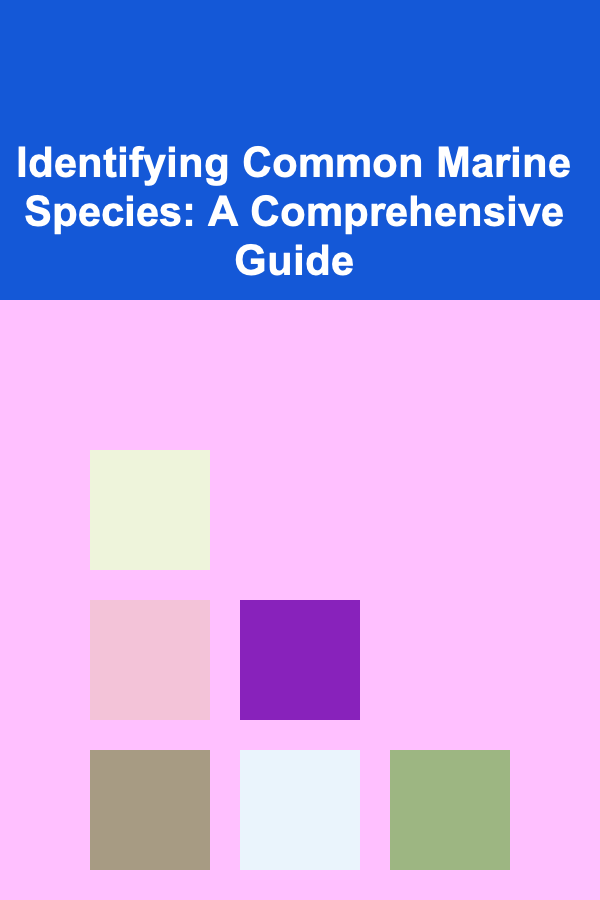
Identifying Common Marine Species: A Comprehensive Guide
ebook include PDF & Audio bundle (Micro Guide)
$12.99$11.99
Limited Time Offer! Order within the next:

The ocean, a vast and mysterious realm, teems with an incredible diversity of life. From the microscopic plankton to the majestic whales, marine species play crucial roles in maintaining the health and balance of our planet. Identifying these species can be a rewarding and enlightening experience, whether you're a seasoned diver, a beachcomber, or simply curious about the natural world. This comprehensive guide will equip you with the knowledge and skills necessary to identify common marine species, focusing on key characteristics, habitats, and helpful resources.
Understanding the Importance of Marine Species Identification
Beyond the sheer fascination of knowing what you're looking at, accurate marine species identification is vital for several reasons:
- Conservation: Correct identification allows us to track populations, monitor their health, and understand the impact of human activities on their survival. Misidentification can lead to inaccurate data and ineffective conservation efforts. For example, confusing two similar-looking sea turtles could underestimate the population size of a vulnerable species.
- Ecological Research: Marine ecosystems are complex and interconnected. Identifying species is fundamental to understanding food webs, predator-prey relationships, and the overall functioning of these ecosystems. Knowing which species are present in a particular area helps researchers assess the health and stability of the environment.
- Environmental Monitoring: Certain species are indicators of environmental health. Their presence, absence, or changes in abundance can signal pollution, climate change impacts, or habitat degradation. For instance, the decline of coral reefs and the bleaching of corals serve as stark warnings about the effects of rising ocean temperatures.
- Responsible Recreation: Whether you're diving, snorkeling, fishing, or simply exploring the coastline, knowing what you're encountering allows you to interact responsibly with the marine environment. Understanding which species are protected, which are venomous or dangerous, and how to avoid disturbing their habitats is crucial for minimizing your impact.
- Citizen Science: Anyone can contribute to our understanding of marine life by participating in citizen science projects. These projects often rely on accurate species identification to collect valuable data on distribution, abundance, and behavior. Apps and online platforms now make it easier than ever to report sightings and contribute to scientific research.
Key Characteristics Used for Identification
Identifying marine species relies on observing and analyzing a variety of physical characteristics. The relative importance of each characteristic depends on the group of animals or plants you are trying to identify. Here are some of the most important features to consider:
General Body Shape and Size
The overall shape and size are often the first clues. Is it streamlined like a fish, round like a jellyfish, or elongated like a worm? Consider the proportions of the body and the relative sizes of different parts. Is it small enough to fit in your hand, or larger than a car?
Coloration and Pattern
Color plays a significant role in identification. Note the dominant colors, as well as any patterns, spots, stripes, or markings. Are the colors uniform, or do they change across the body? Are there iridescent or shimmering effects? Keep in mind that coloration can vary depending on age, sex, and geographic location.
Appendages and External Structures
Examine the presence, number, and arrangement of appendages such as fins, legs, tentacles, or antennae. Note the shape and size of these structures. For example, the number and arrangement of spines on a sea urchin, or the shape of the claws on a crab, are important identification features.
Habitat and Behavior
Where you find a species and how it behaves can provide valuable clues to its identity. Is it found in shallow coastal waters, deep ocean trenches, or coral reefs? Does it swim, crawl, burrow, or attach to rocks? Is it solitary or does it live in groups? Observe its feeding behavior, movement patterns, and interactions with other organisms.
Specific Anatomical Features (Requires Closer Observation)
Sometimes, more detailed examination is required to identify a species accurately. This might involve looking at specific anatomical features such as the shape of the mouth, the arrangement of teeth, the presence of scales, or the structure of the gills. However, such observations might require catching (and then releasing) or handling the animal, which should be done responsibly and only when necessary.
Identifying Common Marine Species Groups
Let's explore how to identify some common marine species groups, focusing on the characteristics mentioned above.
Fish
Fish are incredibly diverse, but some key features can help with identification:
- Body Shape: Is it laterally compressed (flat side-to-side) like a flounder, elongated like an eel, or torpedo-shaped like a tuna?
- Fin Arrangement: Note the number, position, and shape of the fins (dorsal, pectoral, pelvic, anal, caudal).
- Coloration and Pattern: Observe the colors and patterns, including stripes, spots, bars, and gradients. Many fish have distinctive color patterns for camouflage or signaling. For example, clownfish are easily recognized by their bright orange bodies with white bars.
- Mouth Shape and Teeth: The shape of the mouth and the type of teeth can indicate feeding habits. A small, downward-pointing mouth might indicate a bottom feeder, while a large mouth with sharp teeth suggests a predator.
Examples:
- Great White Shark (Carcharodon carcharias): Large, torpedo-shaped body, grey coloration, prominent dorsal fin, powerful jaws with serrated teeth. Found in temperate oceans worldwide.
- Clownfish (Amphiprioninae): Bright orange body with white bars, small size, lives in anemones. Found in the Indo-Pacific region.
- Flounder (various species): Laterally compressed body, both eyes on the same side of the head, often camouflaged against the seabed.
Great White Shark
Clownfish
Marine Mammals
Marine mammals include whales, dolphins, seals, and sea lions. Key characteristics for identification include:
- Body Shape: Is it streamlined like a dolphin, bulky like a whale, or torpedo-shaped like a seal?
- Size: Marine mammals vary greatly in size, from the tiny vaquita to the enormous blue whale.
- Presence of Fins or Flippers: Note the shape, size, and position of fins and flippers. Dolphins have a prominent dorsal fin, while seals have smaller flippers.
- Blowhole Shape: Whales have blowholes on the top of their heads. The shape and number of blowholes can help identify different species. For example, baleen whales have two blowholes, while toothed whales have one.
- Fur or Blubber: Seals and sea lions have fur for insulation, while whales and dolphins rely on blubber.
Examples:
- Humpback Whale (Megaptera novaeangliae): Large whale with long pectoral fins, distinctive hump on its back, known for its complex songs. Found in oceans worldwide.
- Bottlenose Dolphin (Tursiops truncatus): Streamlined body, prominent dorsal fin, intelligent and social animals. Found in warm and temperate waters worldwide.
- Harbor Seal (Phoca vitulina): Torpedo-shaped body, small flippers, spotted coat, often seen hauled out on rocks. Found in coastal waters of the Northern Hemisphere.
Humpback Whale
Bottlenose Dolphin
Sea Turtles
Sea turtles are reptiles adapted to marine life. Identification relies on:
- Shell Shape: The shape and size of the carapace (upper shell) and plastron (lower shell) are important. Some species have a heart-shaped carapace, while others have a more elongated shape.
- Scale Arrangement: The number and arrangement of scales on the head and flippers can also be used for identification.
- Coloration: Note the color of the shell and skin.
- Number of Claws on Flippers: Some species have claws on their flippers, while others do not.
Examples:
- Loggerhead Sea Turtle (Caretta caretta): Large head, reddish-brown carapace, strong jaws. Found in temperate and tropical oceans worldwide.
- Green Sea Turtle (Chelonia mydas): Heart-shaped carapace, olive-green coloration, herbivorous diet. Found in tropical and subtropical oceans worldwide.
- Leatherback Sea Turtle (Dermochelys coriacea): Lacks a hard shell, has a leathery carapace with longitudinal ridges, the largest sea turtle species. Found in oceans worldwide.
Loggerhead Sea Turtle
Green Sea Turtle
Invertebrates (Crustaceans, Mollusks, Echinoderms)
Marine invertebrates are incredibly diverse and include crustaceans (crabs, shrimp, lobsters), mollusks (snails, clams, squid, octopuses), and echinoderms (sea stars, sea urchins, sea cucumbers). Identification can be challenging, but here are some key features:
- Crustaceans:
- Number of Legs: Crabs typically have 10 legs (5 pairs), while shrimp and lobsters have various numbers of appendages.
- Claw Shape and Size: Note the shape and size of the claws, which can vary greatly between species.
- Body Shape and Segmentation: Observe the shape of the body and the segmentation of the exoskeleton.
- Mollusks:
- Shell Shape and Pattern: For shelled mollusks like snails and clams, the shape, size, color, and pattern of the shell are crucial.
- Number of Arms or Tentacles: Octopuses have eight arms, while squids have eight arms and two tentacles.
- Presence of a Shell: Some mollusks, like slugs and nudibranchs, lack an external shell.
- Echinoderms:
- Number of Arms or Rays: Sea stars typically have five arms (though some species have more), while sea urchins have a spherical body covered in spines.
- Spine Arrangement: The arrangement and type of spines on sea urchins are important.
- Body Shape and Texture: Observe the overall shape and texture of the body. Sea cucumbers have elongated, leathery bodies.
Examples:
- Dungeness Crab (Metacarcinus magister): Large crab with a broad, oval carapace, commercially important species. Found in the Pacific Northwest of North America.
- Giant Squid (Architeuthis dux): Enormous squid with eight arms and two tentacles, lives in deep ocean waters.
- Sunflower Sea Star (Pycnopodia helianthoides): Large sea star with numerous arms (up to 24), fast-moving predator. Found in the North Pacific Ocean.
Dungeness Crab
Giant Squid (Illustration)
Marine Plants and Algae
Marine plants and algae are the primary producers in many marine ecosystems. Identification often involves looking at:
- Leaf Shape and Size: Note the shape, size, and arrangement of the leaves or blades.
- Color: Algae can be green, brown, or red.
- Habitat: Where does it grow -- submerged in shallow water, attached to rocks, or floating freely?
- Overall Structure: Is it a tall, branching seaweed, a short, turf-forming alga, or a flowering seagrass?
Examples:
- Kelp (various species): Large, brown algae that form underwater forests, important habitat for many marine species. Found in cold, nutrient-rich waters.
- Seagrass (various species): Flowering plants that grow submerged in shallow coastal waters, provide habitat and stabilize sediments.
- Sea Lettuce (Ulva lactuca): Thin, green algae that resembles lettuce leaves, grows in intertidal zones.
Kelp Forest
Tools and Resources for Marine Species Identification
Identifying marine species can be challenging, but there are many helpful tools and resources available:
- Field Guides: Region-specific field guides are invaluable for identifying local marine species. Look for guides with detailed descriptions, illustrations, and photographs.
- Online Databases and Websites: Websites like the Encyclopedia of Life, FishBase, and the World Register of Marine Species (WoRMS) provide comprehensive information on marine species.
- Mobile Apps: Several mobile apps are available for marine species identification, often using image recognition technology. Some popular apps include iNaturalist, Picture Fish, and Seek.
- Local Experts: Contact local marine biologists, natural history museums, or dive shops for assistance with identification.
- Citizen Science Projects: Participate in citizen science projects to learn from experts and contribute to scientific research. Platforms like Zooniverse offer many marine-related projects.
- Diving and Snorkeling Courses: Many diving and snorkeling courses include instruction on marine species identification.
Tips for Successful Marine Species Identification
Here are some helpful tips to improve your marine species identification skills:
- Start with the Basics: Focus on identifying broad groups of organisms (e.g., fish, mammals, invertebrates) before trying to identify specific species.
- Observe Carefully: Pay close attention to the key characteristics discussed earlier -- body shape, coloration, appendages, habitat, and behavior.
- Take Good Photos: If possible, take clear photos of the species from different angles. These photos can be helpful for later identification.
- Record Location and Habitat: Note the location where you found the species and the type of habitat (e.g., rocky shore, coral reef, open ocean).
- Compare with Multiple Resources: Don't rely on just one source of information. Compare your observations with multiple field guides, websites, and apps.
- Be Patient and Persistent: Marine species identification can be challenging, so don't get discouraged if you don't get it right away. Keep practicing and learning!
- Respect the Environment: When observing marine life, be sure to do so responsibly and minimize your impact on the environment. Avoid disturbing animals or their habitats.
Disclaimer: This guide provides general information on identifying common marine species. It is not a substitute for expert advice. Identification can be challenging, and some species may be difficult to distinguish. Always consult with reliable sources and local experts for accurate identification. Observe marine life responsibly and avoid disturbing animals or their habitats.

How to Find Cost-Effective Gym Memberships Without Compromising Quality
Read More
How to Plan for Seasonal Expenses in Your Budget
Read More
How to Use Cash Envelopes for Better Home Budgeting Control
Read More
How to Use Vertical Space for Efficient Home Storage
Read More
How To Support Anti-Poaching Initiatives
Read More
How to Write Poetry About Grief
Read MoreOther Products

How to Find Cost-Effective Gym Memberships Without Compromising Quality
Read More
How to Plan for Seasonal Expenses in Your Budget
Read More
How to Use Cash Envelopes for Better Home Budgeting Control
Read More
How to Use Vertical Space for Efficient Home Storage
Read More
How To Support Anti-Poaching Initiatives
Read More